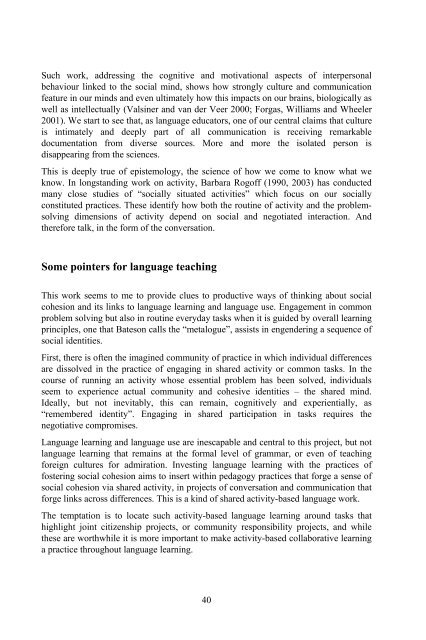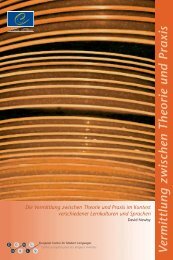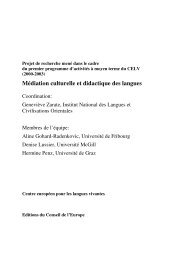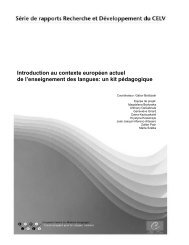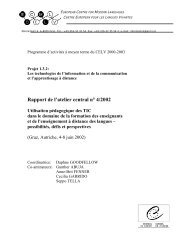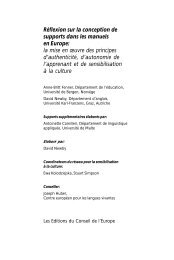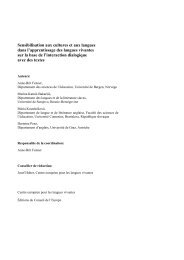cohesion - European Centre for Modern Languages
cohesion - European Centre for Modern Languages
cohesion - European Centre for Modern Languages
Create successful ePaper yourself
Turn your PDF publications into a flip-book with our unique Google optimized e-Paper software.
Such work, addressing the cognitive and motivational aspects of interpersonal<br />
behaviour linked to the social mind, shows how strongly culture and communication<br />
feature in our minds and even ultimately how this impacts on our brains, biologically as<br />
well as intellectually (Valsiner and van der Veer 2000; Forgas, Williams and Wheeler<br />
2001). We start to see that, as language educators, one of our central claims that culture<br />
is intimately and deeply part of all communication is receiving remarkable<br />
documentation from diverse sources. More and more the isolated person is<br />
disappearing from the sciences.<br />
This is deeply true of epistemology, the science of how we come to know what we<br />
know. In longstanding work on activity, Barbara Rogoff (1990, 2003) has conducted<br />
many close studies of “socially situated activities” which focus on our socially<br />
constituted practices. These identify how both the routine of activity and the problemsolving<br />
dimensions of activity depend on social and negotiated interaction. And<br />
there<strong>for</strong>e talk, in the <strong>for</strong>m of the conversation.<br />
Some pointers <strong>for</strong> language teaching<br />
This work seems to me to provide clues to productive ways of thinking about social<br />
<strong>cohesion</strong> and its links to language learning and language use. Engagement in common<br />
problem solving but also in routine everyday tasks when it is guided by overall learning<br />
principles, one that Bateson calls the “metalogue”, assists in engendering a sequence of<br />
social identities.<br />
First, there is often the imagined community of practice in which individual differences<br />
are dissolved in the practice of engaging in shared activity or common tasks. In the<br />
course of running an activity whose essential problem has been solved, individuals<br />
seem to experience actual community and cohesive identities – the shared mind.<br />
Ideally, but not inevitably, this can remain, cognitively and experientially, as<br />
“remembered identity”. Engaging in shared participation in tasks requires the<br />
negotiative compromises.<br />
Language learning and language use are inescapable and central to this project, but not<br />
language learning that remains at the <strong>for</strong>mal level of grammar, or even of teaching<br />
<strong>for</strong>eign cultures <strong>for</strong> admiration. Investing language learning with the practices of<br />
fostering social <strong>cohesion</strong> aims to insert within pedagogy practices that <strong>for</strong>ge a sense of<br />
social <strong>cohesion</strong> via shared activity, in projects of conversation and communication that<br />
<strong>for</strong>ge links across differences. This is a kind of shared activity-based language work.<br />
The temptation is to locate such activity-based language learning around tasks that<br />
highlight joint citizenship projects, or community responsibility projects, and while<br />
these are worthwhile it is more important to make activity-based collaborative learning<br />
a practice throughout language learning.<br />
40


